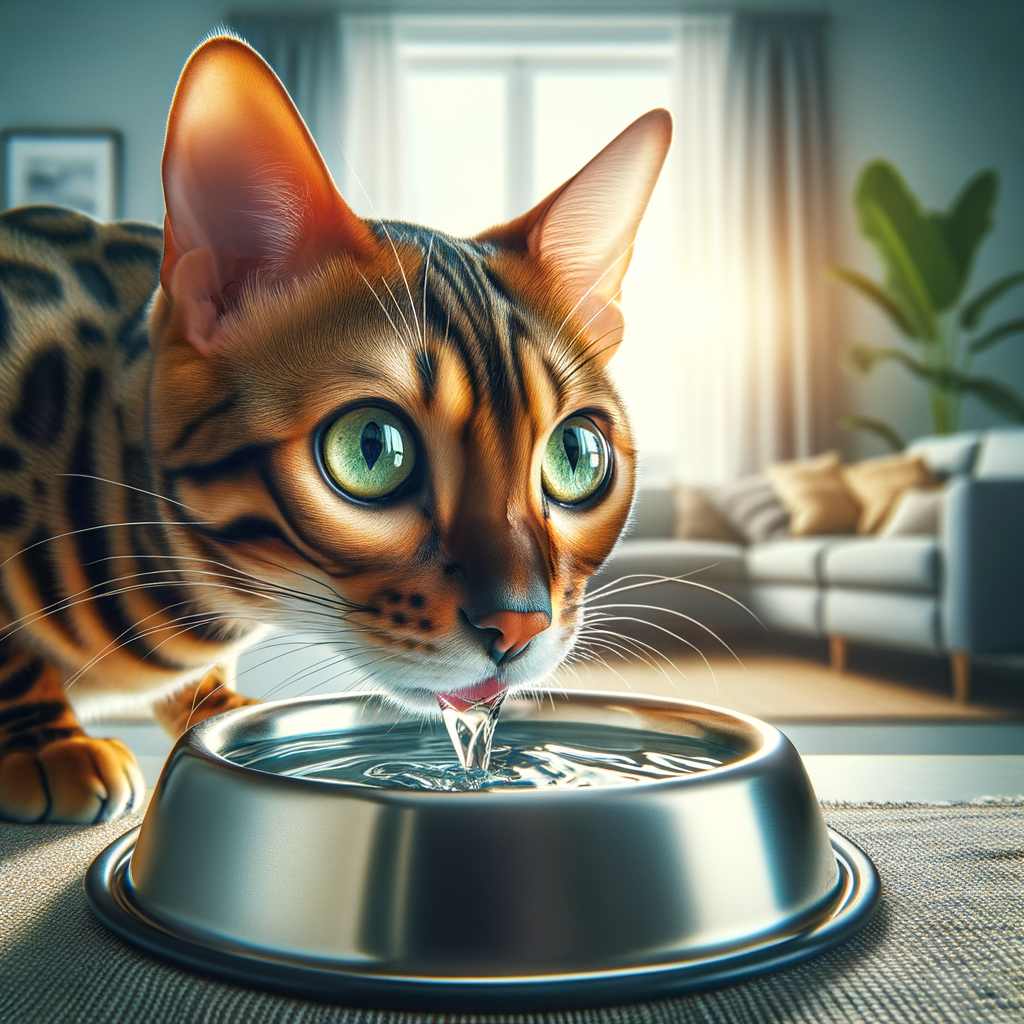
The Importance of Hydration for Bengal Cats
Water is essential for all cats, but it’s especially crucial for Bengal cats. Proper hydration helps their bodies function well. It aids in digestion, keeps their fur shiny, and helps their organs work correctly.
- Bengal cat drinking habits:
Bengal cats are known for their playful nature, and sometimes they might get too busy to drink water. They might prefer running water, like from a fountain, over still water in a bowl. Observing their drinking habits can help ensure they get enough water.
- Bengal cat health and hydration:
Keeping Bengal cats hydrated can prevent health issues like urinary tract infections and kidney problems. Dehydration can lead to serious health problems, so it’s important to make sure they always have fresh water available.
Hydration Tips for Bengal Cats
- Keeping Bengal cats hydrated:
Ensuring your Bengal cat stays hydrated is crucial. Always provide fresh water. Place multiple water bowls around your home. Use a water fountain to encourage drinking. Bengal cats love moving water!
- Water intake for Bengal cats:
Bengal cats need about 3.5 to 4.5 ounces of water per 5 pounds of body weight daily. Monitor their water intake. If they are not drinking enough, try adding water to their food. Wet cat food can also help increase their water intake.
- Hydration benefits for Bengal cats:
Proper hydration helps keep your Bengal cat’s kidneys healthy. It also aids digestion and keeps their skin and coat shiny. Hydrated cats are more energetic and playful. Remember, a well-hydrated cat is a happy cat!
Preventing Dehydration in Bengal Cats
Recognizing Dehydration Symptoms
Dehydration in Bengal cats can be a serious issue. It’s important to recognize the signs early to ensure your cat stays healthy. Here are some key symptoms to look out for:
- Physical signs of dehydration in Bengal cats:
- Dry gums: Check your cat’s gums. If they are dry or sticky, it could be a sign of dehydration.
- Sunken eyes: Dehydrated cats may have eyes that appear sunken.
- Loss of skin elasticity: Gently pinch the skin at the back of your cat’s neck. If it doesn’t snap back quickly, your cat might be dehydrated.
- Behavioral changes due to dehydration:
- Lethargy: A dehydrated cat may seem unusually tired or inactive.
- Loss of appetite: Dehydration can cause a cat to eat less.
- Frequent panting: If your cat is panting more than usual, it could be a sign of dehydration.
Steps to Prevent Dehydration
- Ensuring Adequate Water Supply
Always make sure your Bengal cat has access to fresh, clean water. Place multiple water bowls around your home to encourage drinking. Cats prefer running water, so consider using a cat water fountain. According to a study by the American Veterinary Medical Association, cats are more likely to drink from moving water sources.
- Encouraging Drinking Habits
Encourage your Bengal cat to drink more water by adding a bit of flavor to it. You can mix in a small amount of tuna juice or chicken broth. Another trick is to provide wet cat food, which has higher water content compared to dry food. This helps in keeping your cat hydrated.
- Monitoring Bengal Cat’s Water Intake
Keep an eye on how much water your Bengal cat is drinking. Use a measuring cup to refill their water bowls and note the amount. If you notice a significant decrease in water intake, consult your vet immediately. Dehydration can lead to serious health issues.
Conclusion: Bengal Cat Water Needs
Understanding the water needs of Bengal cats is crucial for their health and happiness. Proper hydration helps them stay active and prevents many health issues.
- Importance of understanding Bengal cat hydration:
Bengal cats, like all cats, need plenty of water to stay healthy. They are very active and can easily become dehydrated. Knowing how much water they need helps keep them in top shape.
- Key tips for keeping Bengal cats hydrated:
- Always provide fresh water. Change it daily to keep it clean.
- Use a water fountain. Bengal cats love moving water, and it encourages them to drink more.
- Add wet food to their diet. Wet food has high water content, which helps with hydration.
- Monitor their drinking habits. If you notice any changes, consult your vet.
- Preventing dehydration in Bengal cats:
Dehydration can be dangerous. Signs include dry gums, lethargy, and loss of appetite. If you suspect your Bengal cat is dehydrated, seek veterinary help immediately.
By understanding and meeting the water needs of your Bengal cat, you ensure they live a healthy and happy life. Always keep an eye on their hydration and consult your vet if you have any concerns.






